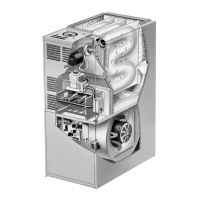Page 1
ã 1998 Lennox Industries Inc.
Corp. 9814-L8
G23(X)
Service Literature
Revised 08-2001
G23(X) SERIES UNITS
G23(X) series units are mid-efficiency upflow gas fur-
naces manufactured with Duralokt aluminized steel
clamshell type heat exchangers. G23(X) units are avail-
able in heating capacities of 50,000 to 150,000 Btuh and
cooling applications up to 6 tons. Refer to Engineering
Handbook for proper sizing.
Units are factory equipped for use with natural gas. A kit is
available for conversion to LPG operation. G23(X)-1, -2, -3
and-4modelunitsuseelectronic (intermittentpilot)ignition.
G23(X)-5 and -6 model units feature the Lennox Sur-
eLightT silicon nitride ignition system. All units meet the
California Nitrogen Oxides (NO
x
) Standards and California
Seasonal Efficiency requirements with the installation of
flame baffles. All units use a redundant gas valve to assure
safety shut-off as required by A.G.A. or C.G.A.
Information contained in this manual is intended for use by
qualified service technicians only. All specifications are
subject to change. Procedures outlined in this manual are
presented as a recommendation only and do not super-
sede or replace local or state codes. In the absence of lo-
cal or state codes, the guidelines and procedures outlined
in this manual (except where noted) are recommended
only.
SPECIFICATIONS
Model No. G23Q2(X)-50 G23Q3(X)-50 G23Q2/3(X)-75 G23Q4/5(X)-75 G23Q3(X)-100
Input Btuh (kW) 50,000 (14.7) 75,000 (22.0) 100,000 (29.3)
Output Btuh (kW) 40,000 (11.7) 61,000 (17.8) 80,000 (23.4)
lA.F.U.E. 80.7% 80.8% 80.4% 80.1%
California Seasonal Efficiency 75.5% 75.6% 76.9% 74.2% 76.6%
Flue size connection diameter— in. (mm) round 3 (76) 4 (102)
Temperature rise range — _F (_C) 30-60 (17-33) 35-65 (19-36) 20-50 (11-28) 45-75 (25-42)
High static certified by A.G.A. — in wg. (Pa) .50 (125)
in. 1/2
Natural or LPG/propane
mm 12.7
in. 10 x 7 10 x 8 11-1/2 x 9 10 x 8
diameter x width
mm 254 x 178 254 x 203 292 x 229 254 x 203
Blower motor output — hp (W) 1/5 (149) 1/3 (249) 3/4 (560) 1/3 (249)
Tons 1 to 2 1 to 3 3-1/2 to 5 1 to 3
that can be added
kW 3.5 to 7.0 3.5 to 10.6 12.3 to 17.6 3.5 to 10.6
Shipping weight — lbs. (kg) 1 package 135 (61) 140 (64) 146 (66) 186 (84) 159 (72)
Electrical characteristics 120 volts — 60 hertz — 1 phase (all models) (less than 12 amps)
lAnnual Fuel Utilization Efficiency based on U.S. DOE test procedures and FTC labeling regulations. Isolated combustion system rating for non-weatherized furnaces.
}Cleanable polyurethane frame type filter.












